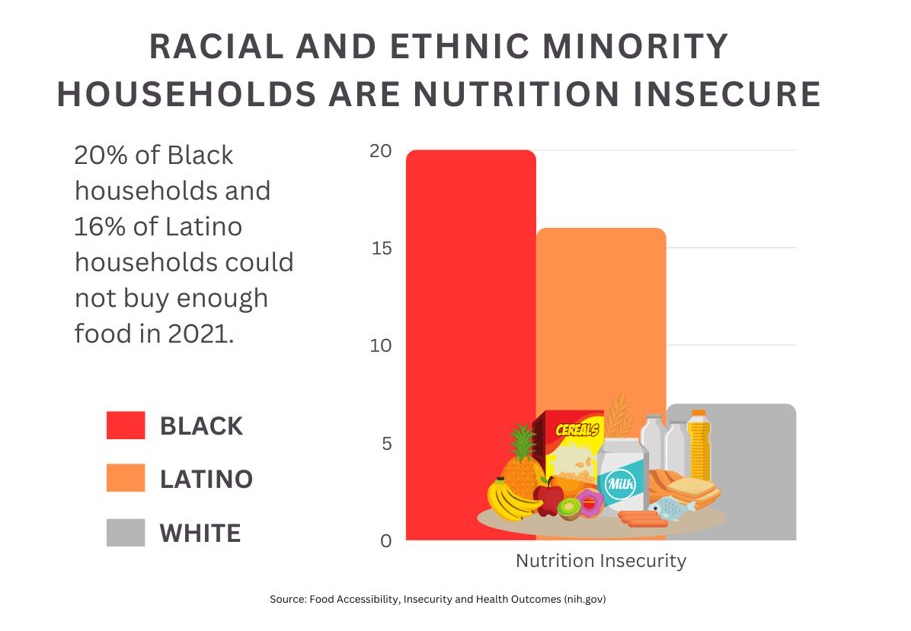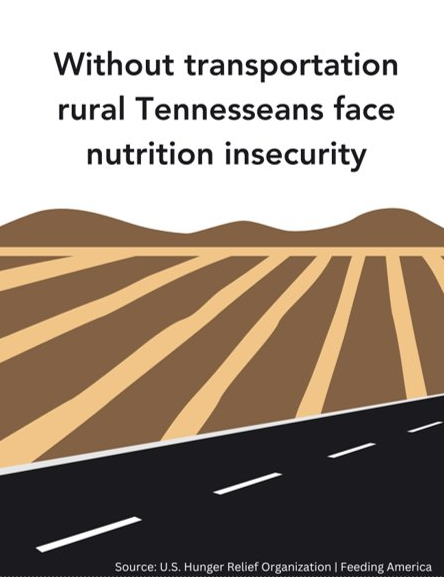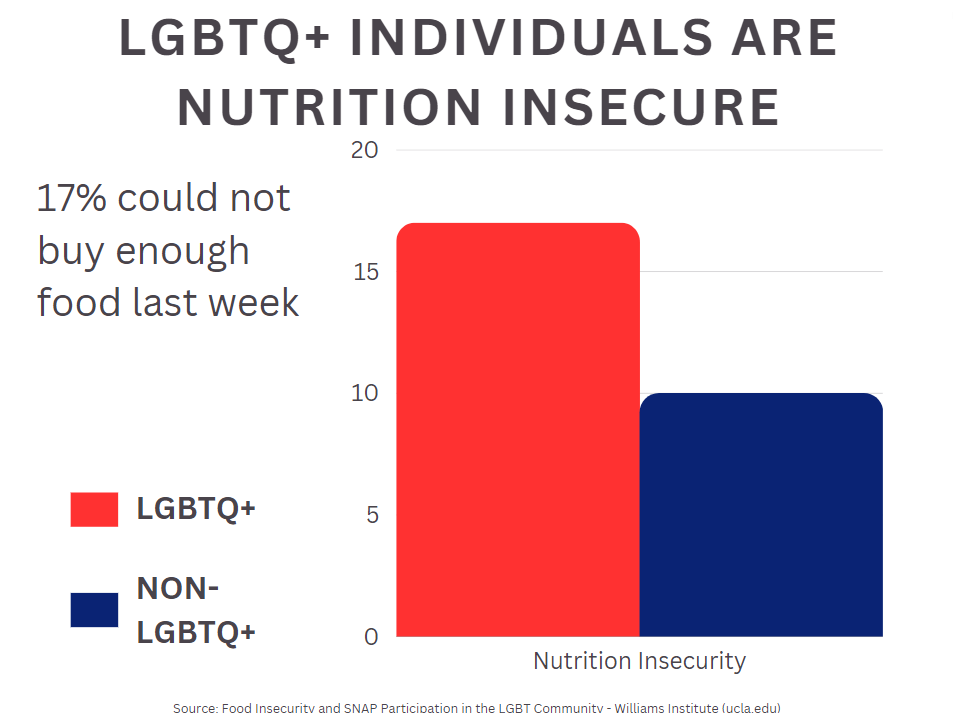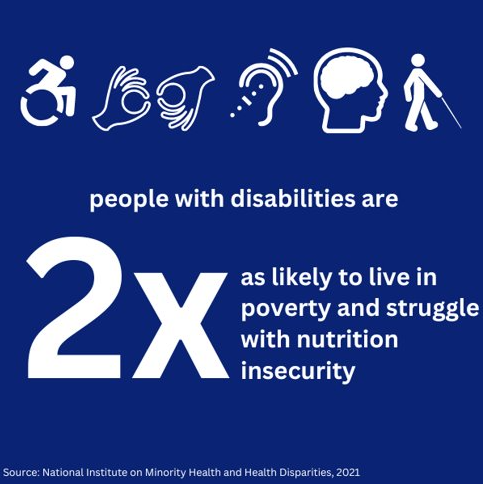Nutrition Security
Communities benefit when they have consistent access to foods and beverages that are affordable, nutritionally balanced, appropriate for the community’s culture, and fit easily into people’s everyday lives. When communities can access these options, their risk for chronic disease decreases, school and work performance improves, and ongoing stress is prevented.
Here we want to focus not just on nutrition, but on nutrition security. Nutrition security is more than just a balanced diet filled with fresh fruits and vegetables. These are important, but they might be difficult for people to incorporate into their diets for many reasons. People might live in a town that does not have a grocery store that stocks fresh produce, they might be a working parent with limited time on their hands, or they might be working with a tight budget for groceries – these are only a few of the barriers that can get in the way of nutrition security.
Nutrition security has many aspects to it:
Food Availability: The physical availability of food
Food Utilization: Having knowledge about healthy nutrition, having enough time to prepare meals, and the ability to eat according to your cultural food preferences
Access to Food: Being able to afford groceries and easily travel to purchase fresh food
Nutritional Quality of Food: How rich in nutrients, balanced, and safe your food is
Stability: All other aspects of nutrition security listed above are steady and consistent in the long term
When one piece of the puzzle is missing, it threatens an individual or community’s overall nutrition security. To make an impact on the nutrition security of their community, County Health Councils can address one or more of these dimensions and create a more robust understanding of what it takes to reach nutrition security.
Good nutrition is the foundation for healthy bodies and minds, and sets us up to work, play, and learn to the best of our abilities. Consuming nutritionally balanced food and beverages gives people energy to be active, whether it’s for a job, a sports team, a fitness hobby, or keeping up with children or grandchildren. It can decrease feelings of stress, boost your mood, and improve sleep quality. Poor nutrition is associated with increased risk for multiple chronic health conditions such as diabetes, obesity, heart disease, and even some cancers. Knowing that you and your family will be able to afford and access healthy food and have the time and energy to prepare it in the long term lessens the mental burden and overall stress of a household. When people have access to healthy foods that fit into their lives and cultures, their physical and mental health are improved overall.
Children who experience nutrition insecurity are more likely to have a decrease in school performance and cognitive development and are more likely to exhibit anxiety and aggression. Kids in food-insecure households are 2-3 times more likely to have anemia and 1-2 times more likely to have asthma than their peers in food-secure households. Ensuring that children are nutritionally secure means that they are set up for academic, social, and personal success. Nutrition security is especially important for developing our communities’ next generations.
Though poor nutrition affects every group of people, diet-related diseases are seen more often among those who are historically underserved because of barriers that impact these groups.
Racial and Ethnic Minorities
Food insecurity disproportionately impacts low-income communities of color. A report from the USDA Economic Research Service found that 16% of Hispanic individuals and 20% of Black individuals experience food insecurity compared to 7% of their White counterparts.


Rural Communities
In rural areas, the lack of public transportation options can make it difficult or expensive to travel to grocery stores, food banks, and famers markets. In some areas limited grocery store options, especially those offering fresh produce and protein, make it hard to find nutritionally balanced meal options.
LGBTQ+ Individuals
LGBTQ+ individuals and adults in same-sex couples often experience nutrition insecurity at higher levels than their non-LGBTQ+ counterparts, according to a report from the William Institute at UCLA School of Law. Among the LGBTQ+ community, women, younger people, certain racial and ethnic minorities, those without college degrees, unmarried people, and people with children are particularly at risk of nutrition insecurity.


Individuals with Disabilities
According to a study by the National Bureau of Economic Research, average earnings fall by 76% after the onset of a severe or chronic disability, and people with disabilities in the U.S. are twice as likely to live in poverty than those without a disability. Because of this, affording groceries becomes harder. Depending on nearby grocery store and transportation options, it may also be logistically difficult for some people with disabilities to access food. Disabling or chronic health conditions may be made worse by insufficient food or a low-quality diet.
Children
For communities who can't easily access or afford food, or in households where resources are spread across many family members, it may be difficult to meet the nutritional needs of growing kids. Nutrition insecurity rates increase in households with single parents, especially for single mothers with children.
Activities and Programs: Evidence-informed, actionable, short-term steps that collaborative groups can take to address priority areas.
Policy and Systems Change: Systems change refers to how organizations or programs — such as school systems or health systems — are connected and work together to improve conditions to make change that lasts. This section contains evidence-informed, actionable, long-term steps that collaborative groups can take to address priority areas.
- Destigmatize participation in food assistance policies. Some people eligible for programs like SNAP and WIC may be reluctant to seek help—or not even know they’re eligible—because of stigma or misinformation about the programs. Emphasize that because anyone who meets eligibility requirements can participate in SNAP, getting SNAP benefits doesn’t affect other people’s ability to get it as well, so people shouldn’t be worried about taking help away from “others who need it more.”
- Partner with a school or neighborhood organization to host a community cooking club or plant a community garden. Connecting with other groups in your local area to talk and learn about nutrition is a great way to share resources and get neighbors excited about food access and utilization. Focus on meals that are quick and easy for working families or seniors using groceries available through SNAP and WIC.
- Connect community members to Nutrition Assistance Programs like Supplemental Nutrition Assistance Program (SNAP) and Special Supplemental Nutrition Program for Women, Infants, and Children (WIC). Make it easier for people to access benefits by providing technical assistance with applications.
- Support local Tennessee School-Based Nutrition Programs like Seamless Summer Feeding Options, which provide free meals to schools in qualified low-income areas during summer vacation. Promote the community’s knowledge of existing services so that kids who qualify can access available services throughout the year.
- Connect individuals to social workers, community health workers, and community organizations to provide direct support to meet their social needs. Encourage the practice of patient screenings that include Social Drivers of Health such as nutrition security with providers in your community.
- Work with your local UT Extension office to engage with the local agriculture community. Build stronger bridges between local farmers and the greater community and encourage farmers to participate in Tennessee’s Farmers Market Nutrition Program.
Murfreesboro City Schools CHOW Bus:
To ensure children across the area were getting fed even during summer vacation, Murfreesboro City Schools introduced the CHOW (Combatting Hunger on Wheels) Bus, a mobile extension of the Summer Food Service Program. Kids 18 and under can stop at designated CHOW Bus locations in nearby apartment complexes, parks, and community centers to receive free breakfast and lunch from retired school buses decked out in painted farm animals. This initiative fills a gap in the community, bringing nutritious food to children in Murfreesboro who may experience nutrition insecurity once school is out for the summer.
Contact Sandy Scheele at sandy.scheele@cityschools.net
TN Department of Human Services
- Supplemental Nutrition Assistance Program (SNAP) provides qualifying households with a grocery stipend, the amount of which depends on the household’s resources and situation. Click here to learn more about eligibility and applications.
TN Department of Health
- Tennessee Story Map is a tool that offers a deep look at Child and Adult Care Food Program (CACFP) participation across the state, food deserts in TN, areas of potential CACFP eligibility, the intersection between food security and poverty, and strategies for change. Spotlights include Chattanooga, Tri-Cities, Jackson, and the West TN Region.
- The Data Dashboard is an interactive map featuring all the data included in the Tennessee Story Map. It includes the ability to toggle layers on and off and filter childcare providers by participation in CACFP and county.
- Special Supplemental Nutrition Program for Women, Infants, and Children (WIC) is a nutrition assistance program designed to support low-income pregnant, postpartum, and breastfeeding women, infants, and children until age five. In addition to supplemental food, WIC provides nutrition education, breastfeeding support, and referrals to other health and community services.
- WICShopper is an app that can help you verify WIC eligibility as you shop, save recipes and grocery lists, and view your remaining balance.
- The Farmer’s Market Nutrition Program (FMNP) provides locally grown produce to Tennesseans participating in WIC and eligible older adults. All fruits, vegetables, and herbs are grown by local Tennessee famers, connecting FMNP participants to their community in healthy, beneficial ways.
UT Extension
- Publications and Media Catalogue is an extensive library of UT Extension’s educational materials on nutrition, from guides to buying fresh produce to food safety tips.
- Food Programs are offered across the state by individual UT Extension offices on subjects from cooking for diabetes management to food preservation. Contact your local office for more information.
Iowa State University Extension and Outreach
- Spend Smart Eat Smart is a comprehensive initiative that walks you step by step through how to Plan, Shop, and Cook to eat healthy and stick to a tight grocery budget. With handouts and videos, this tool will help calculate a grocery budget based on your household, compare products in a grocery store, set up your kitchen for success, and guide you through preparation and storing for tons of different produce.
Hunger Free America
- Find Food is a tool that identifies local food services from food pantries to soup kitchens, with results available specifically in Spanish, for seniors, or for Halal or Kosher diets. Simply enter your address and locate nearby options that best suit your needs.
USDA
- Dietary Guidelines for Americans offers a framework to help all people enjoy nutrient-dense food that meets their personal, cultural, budgetary, and health needs.
- MyPlate is a tool that breaks down the food groups and provides additional details on each type, from recommended daily portions to healthy recipes. The MyPlate site also includes toolkits on how to communicate about nutrition with children and families, and many materials are available in Spanish.
FDA
- How to Understand and Use the Nutrition Facts Label walks you through each section of the Nutrition Facts label that you find on packaged food to help make the best decisions for your nutrition.
